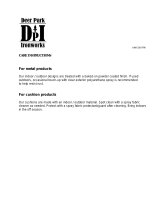
6
7. Site Conditions – All Installations
7.1 Substrate Conditions – The owner or general contractor is responsible for
providing an acceptable substrate for the specified installation.
Note: Installing carpet prematurely before other trades have completed their work will result
in problems with: overall appearance, visible damage, soiling, adhesive failure, delamination
and dimensional stability. These conditions may not be immediately evident. Refer to
Section 16-Protecting Indoor Installations.
7.2 Ambient Temperature and Humidity – The installation is not to begin until the
HVAC system is operational and the following conditions are maintained for at
least 48 hours before, during and 72 hours after completion. The carpet is to be
installed when the indoor temperature is between 65-95ºF (18-35ºC) with a
maximum relative humidity of 65%. The substrate surface temperature should not
be less than 65°F (18°C) at time of installation. Do not allow the temperature of
indoor carpeted areas to fall below 50
o
F (10
o
C), regardless of the age of the
installation. If these conditions are not attainable, contact flooring manufacturer for
applications to warranty.
7.3 Floor Preparation - Carpet is required to be installed over properly prepared
substrates that are suitable for the specific product and installation method
selected. All cracks, holes and flooring irregularities are required to be repaired to
ensure a smooth, finished appearance, prevent accelerated wear and telegraphing
substrate irregularities. Substrates are required to be structurally sound and free
of foreign substances that will compromise the carpet or its installation. Patching
compounds are required to be suitable for the use application. Select polymer-
fortified patching compounds according to the carpet manufacturer’s instructions.
(Refer to
ASTM E1155-96 (2008).
Note: Patched areas may be porous and highly alkaline, which will prevent adequate
adhesive bond. For best results, prime patched areas. Consult patch manufacturer for
primer recommendations and compatibility with adhesives.
7.4 Concrete - Concrete must be cured, clean and dry. Cracks, chips and saw cuts
must be properly patched or treated. Concrete is available in two basic forms;
lightweight and normal weight. This difference is based on the type of aggregate
used in the mix. Lightweight concrete is most commonly, but not exclusively, used
on upper floors. Various screeds and topcoats that are available – typically
gypsum based - are NOT lightweight concrete.
CAUTION: Any concrete floor, even when adequately cured and dry, can allow moisture
vapor to pass through to its surface. Depending upon the type of carpet and method of
installation, the moisture emission rate greatly influences the long-term success of an
installation. The use of a properly installed, uncompromised, approved moisture membrane
is essential in preventing moisture migration into and through a concrete slab. (Ref. ASTM F
710)






















